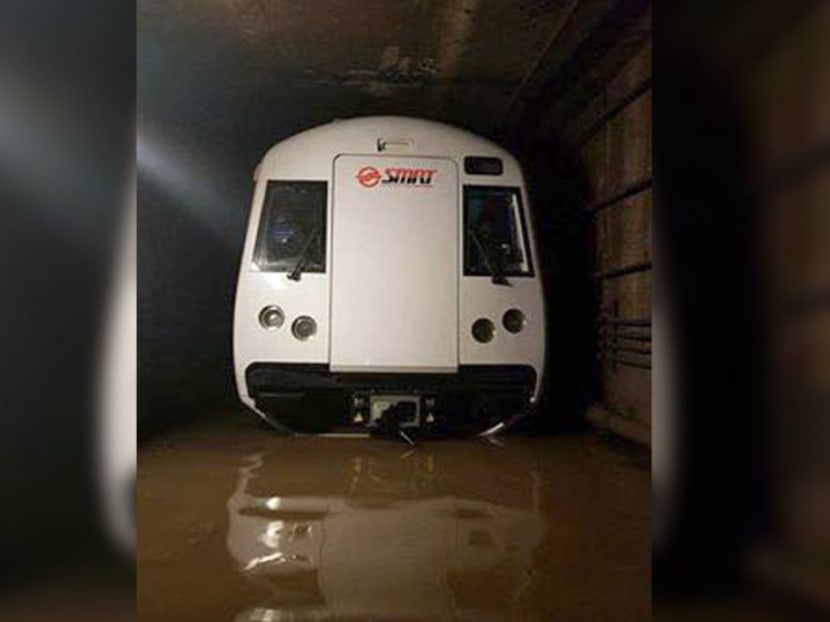LTA and PUB form joint committee to prevent future flooding of tunnels
SINGAPORE — The Land Transport Authority (LTA) and national water agency PUB have formed a joint committee to "institutionalise" the lessons learnt from the Oct 7 flooding of MRT tunnels, and to examine the long-term measures needed to prevent a repeat of such incidents, Transport Minister Khaw Boon Wan said on Tuesday (Dec 5).
SINGAPORE — The Land Transport Authority (LTA) and national water agency PUB have formed a joint committee to "institutionalise" the lessons learnt from the Oct 7 flooding of MRT tunnels, and to examine the long-term measures needed to prevent a repeat of such incidents, Transport Minister Khaw Boon Wan said on Tuesday (Dec 5).
Speaking at an infrastructure maintenance forum at the Environment Building, Mr Khaw said the suggestion came from former PUB chairman Tan Gee Paw, who "painted several dark scenarios" for the two agencies in the aftermath of the flooding that left a stretch of the North-South Line without train services for more than 14 hours, affecting some 231,000 commuters.
In an internal email on Nov 12 that Mr Khaw shared, Mr Tan warned that Singapore could experience heavier periods of rainfall as the typhoon belt shifts southwards. He suggested that Singapore's civil infrastructure should be built to hold sluice gates —which fully seals tunnels against flooding — as is done in Taipei.
"Perhaps we should at least build in the civil infrastructure to accommodate these sluice gates for new tunnels, leaving out the mechanical and electrical equipment and the gates themselves. Our successors in office who may have to deal with near-typhoon rain conditions decades later will be most grateful to us, as retrofitting the civil works for sluice gates is near impossible for a live line," wrote Mr Tan, who is Mr Khaw’s adviser on rail transformation.
Mr Khaw struck a similar note, warning that future generations must not lose sight of the hazard of flooding in the MRT tunnels.
"The PUB-LTA standing committee will institutionalise our lessons and hard-earned experiences, so that all these hard-earned lessons do not disappear with us at the crematorium," he added.
Associate Professor Tan Soon Keat, who specialises in hydraulics at the Nanyang Technological University's School of Civil and Environmental Engineering, said sluice gates serve as an isolation system to keep water at bay.
In most tunnels, such isolation systems are features built in right from the beginning. Retrofitting existing tunnels to allow for these systems will not only be costly but "more than impossible", he said.
Providing for such systems at the design stage will come at a fraction of the cost, added Assoc Prof Tan, noting the possibility of weaving such infrastructure into upcoming rail lines that are presently being planned, such as the Cross Island MRT Line.
Sluice gates can be designed to keep water at certain levels, divert water from a main tunnel, or in "extreme" cases, close off tunnels fully, although Assoc Prof Tan questioned the possibility of completely sealing off tunnels with rail tracks running through them.
One possibility is to have "sub-tunnels" to which water can be diverted and hence sealed from the main tunnel. Assoc Prof Tan said that with measures such as sluice gates, water would still have to be drained out of the tunnels eventually by various means, such as water pumps.
In his speech, the minister also warned that embattled rail operator SMRT could run into "other incidents" going forward, as it races to catch up with maintenance and renewal works. He did not elaborate.
At Tuesday’s forum — organised by the LTA, PUB, SMRT and fellow transport operator SBS Transit — Mr Khaw stressed that engineering design was "straightforward", but regular maintenance as well as periodic audits, checks and tests make the difference in whether anti-flooding measures work.
Calling the Oct 7 incident a “failure of organisational management at SMRT”, Mr Khaw said: “SMRT will learn from it and emerge stronger.”
Eight employees were sacked over the incident, which was set off by flooding in the tunnels between Bishan and Braddell MRT Stations. SMRT also disciplined three management executives over the incident and could pursue legal action against two former executives.
Investigations revealed that maintenance records had been falsified, and work on the Bishan anti-flooding system had not been properly done since December last year.
Mr Khaw sought to rally the rail workers, saying that they filled the hardest role and that the burden on their shoulders was "the heaviest". “Their families are also affected if they see that their loved ones are being screamed at or castigated,” he told his audience.
Urging support for these workers, Mr Khaw said: “Fortunately, the pride in SMRT still lurks among the rank and file. And we can build on that.”









